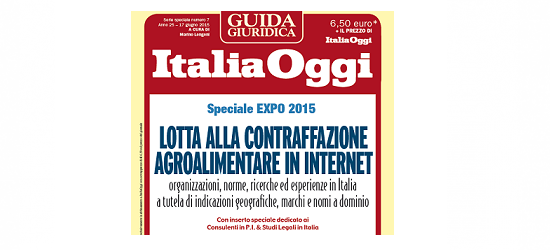
Federica Scorza, Trademark Attorney – Studio Rubino Srl – Roma
The term ”Intellectual Property Rights” includes all the rights (IPRs) regarding to “literary, artistic and scientific works, performances by performing artists, phonograms, and broadcasts, inventions in all fields of human endeavor, scientific discoveries, industrial designs, trademarks, service marks, commercial names and designations, protection against unfair competition, and all other rights resulting from intellectual activity in the industrial, scientific, literary or artistic fields.” (WIPO Establishing Convention)
This concept, however, even in its widest meaning, is continuously expanding, both in content and in its scope of protection, due to the unavoidable process of modernization of laws by technological innovations, that led the legislature to deal with new cases and legal issues connected with the use of the web, and to check the suitability of traditional rules.
Recently, in the last few years, legal developments become relevant and several and they reinforced the protection of IPRs in our country. In addition to the rules laid down and regulated by the Industrial Property Code (Legislative Decree no. 30/2005 et seq.) and other regulations, new laws were approved that provide for and guarantee a better assurance: the Legislative Decree no. 68/2003 in transposition of Directive 2001/29 / EC on the harmonization of certain aspects of copyright and other related rights in the information company; by Law 99/2009 (Development Law) which established the National Anti-Counterfeiting Council (CNAC) at the Ministry of Economic Development; by Law 350/2003 which has established the use of the label “made in Italy“, and later safeguarded the “full made in Italy” which is a fully designed, manufactured, made in Italian territory product; by Law 95/2010 has been sanctioned the administrative protection of the “made in Italy industry“, etc.
What we should aim for is a balanced model of legal protection of IPRs, made to encourage the innovation and competitiveness of the market, but mainly focus on the welfare of final consumers.
Along these things, there have been issued, for example, major judgments regarding copyright, like those released in 2011 by the EU Court of Justice in Scarlet v. Sabam and in 2012 in Sabam v. Netlog proceedings, both with almost similar content, about the responsibility of host provider in relation to violations of IPRs committed by third parties, and perpetrated through unauthorized sharing of content covered by copyright on platforms managed by providers. The Court, in these situations, while guaranteeing and ensuring providers (ISPs) can offer their services in line with the Community rules dictated in e-commerce Directive 2000/31 / EC, has decided that the measures adopted by ISPs to prevent any violation of IPRs, should be fair, proportionate and satisfactory, while fully respecting the fundamental rights of users (mainly privacy and freedom of expression).
In this intricate situation, it’s recommended and necessary an alignment of the different regulations currently in force in matter of industrial property and defense of consumer rights, in order to allow a full and fair protection of parties involved, which would enable holders of IPRs to keep owning their property rights and getting benefit from them, and other consumers to have a better access to the market, being correctly informed about the products and services of creative activity.
